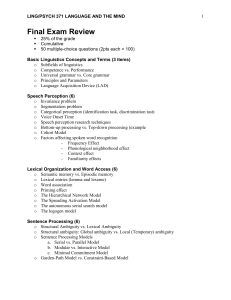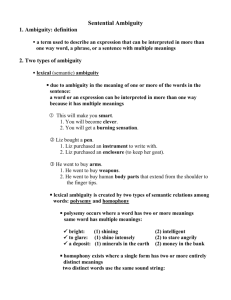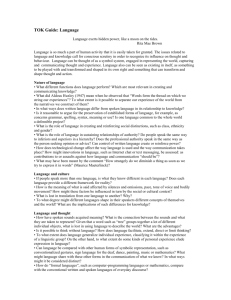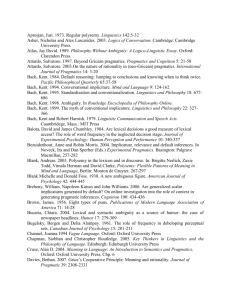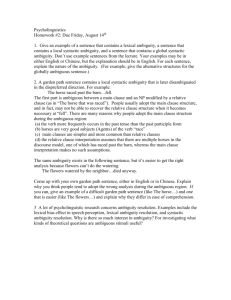CilWi"TER 2 REVl..EW OF RELATED LITERATI.JRE Thls chapter
advertisement
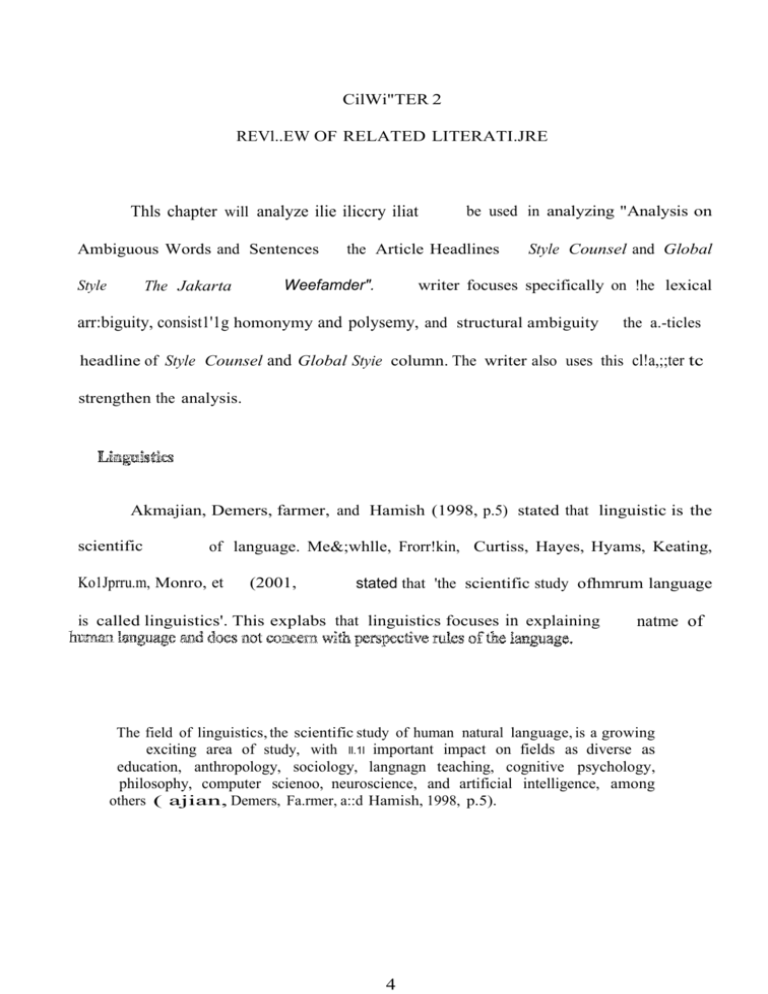
CilWi"TER 2 REVl..EW OF RELATED LITERATI.JRE Thls chapter will analyze ilie iliccry iliat Ambiguous Words and Sentences Style The Jakarta be used in analyzing "Analysis on the Article Headlines Weefamder". Style Counsel and Global writer focuses specifically on !he lexical arr:biguity, consist1'1g homonymy and polysemy, and structural ambiguity the a.-ticles headline of Style Counsel and Global Styie column. The writer also uses this cl!a,;;ter tc strengthen the analysis. Akmajian, Demers, farmer, and Hamish (1998, p.5) stated that linguistic is the scientific of language. Me&;whlle, Frorr!kin, Curtiss, Hayes, Hyams, Keating, Ko1Jprru.m, Monro, et (2001, stated that 'the scientific study ofhmrum language is called linguistics'. This explabs that linguistics focuses in explaining natme of The field of linguistics, the scientific study of human natural language, is a growing exciting area of study, with ll.1l important impact on fields as diverse as education, anthropology, sociology, langnagn teaching, cognitive psychology, philosophy, computer scienoo, neuroscience, and artificial intelligence, among others ( ajian, Demers, Fa.rmer, a::d Hamish, 1998, p.5). 4 5 From t.he quotation above, it is clear that the field of linguistics is not limited to grammatical theory, but it includes a large number of subfields, which is true of most scieoces concerned with phenomer,a as complex as human language. According to Akmlljia:n, Demers, Farmer, a'ld Hamish (1998, p.6) into morphology, phonetics and field linguistics are divided phonemic transcription, phonology, syntax and sen:umties. Portner (in Paso!d ad Linton, 2006, p.l37) stated that the main field of linguistics is study of meanlr..g, consisting semantics and pragmatics. a'lalyzing this paper, the writer only focuses on seoantics theory which will be explaLned furthermore the next point. 2.2. Ambiguity Trask (2007, p.l4) stated that sema."lties is L'le linguistics aspects which studies meaning. On simpler words, Hurford and Heasley (1984, p.l) in Semantics: a Course s"..ated that Sema.'1tics is 'the study of meaning language'. It is important because semantics is the study of how languages organize and express meanings. Tl>,e mea:rlng of language uaually contains two types of meanings, explicit and implicit meaning or other words ambiguity. A.•nbigcity is the of semantics beesuse it is related to meaning. Bach (1994, '1[.1) stated thst 'c. word, phrase, or seotence is ambiguous if it has more than one meani<"1g'. According to Kreidler (1998, p.ll) ambiguity is words or the sentences that has more tha.'1 one meaning. For example: that greasy kid stuti..From the following example it can be seen that the sentence has more than one meaning. The first meaning that stc ff for greasy kid and the second meaning is the kid stuff is greasy. 6 are two types of ambiguity based on Hurford and Heasley (1984, p.l28). a:re lexical ru:d .struct ml ambiguity. Bach (1994, '1[.4) a.l.so grouping ambiguity into two, lexical and structural ambiguity, Trask (2007, p.14} categorize ambiguity into two types: lexical and structural ambiguity. Kea.'llS (2000, p.3) stated lexical as the meaning of the individual words. Hurford Heasley (1984, p.121!) al.so said that lexical ambiguity is any ambiguity resulting the ambiguity of a word. Meanwhile, Trnsk (2007, pJ4) explabs tl',at lexicai ambiguity 'two or more sharply distirrct rneanings for a single string of words'. The follovving ex:unple wi!l explain the definitions above; Example: I v,il! to bank It's lexical ambiguity because the word bank ca."'Tied more than one meaning. The meani"lgs are: first bank meruring is the place for saving money. second bank mearring is tbe side of a river. Hurford and Heasley adds that there are two types of lexical ambiguity, Which are homonymy and polysemy. They stated that 'homonymy is one of an ambiguous word, whose different sense are far apart from each other anci not obviously related to other words anyway' (!984, 123). t.l:!e simple way to describe homonymy is have the same fmm but different meaning or has more than one meaning with nc related sense (Finegan, 1999, p.l98). 7 Polysemy, according to Hurford and Heasley (i984, p.123) is described as 'one where a has several very closely related senses'. Or according to Finegan (1999, pp. 197-198) it refers to words that have same form, and have more than one meaning writer put some exa;nples of homonym and polysemy: related senses. Below, • Homonymy Example: Still word still more than one meaning with :no related sense. Still 2. Yet of Homonymy • Polysemy Exru:nple: The word plain has mo:re one meaning with related senses. ·. . . . W >rdl . ·. Plain 2. 3. . ·. .. Clear ::-!ot good ' . j . Plain English Undecorated Plain · Related Senses Plain white shirt ·o Plain Jane : 8 ·No 4. man, Plains Table Keams (2000, p.3) s+.ated structural ambiguity as 'L'le meaning of the way the words are combhled'. Htnford ambiguity is a sentence Heasley (1984, p.l28) explain lhat structural is ambiguous because of the sentences structure. Following Trask (2007, p.l4) Structural a1nbiguity is 'the words have fue same meanings, but quite different structures can assigned to fue entire string of words, producLdifferent meanings'. Based on Hvmns. Fromkin, and Rodman a sentence has more than one constituent structme, it is ambiguous fu"ltd each tree will correspond to one of the possible mea.'"l.Lqg'. Constituent iructure or P!-JaSe structure is a tree diagram 'l'lith infonnation of syntactic category (2007, p.l23). Below, the "'Titer the example of structural ambiguity: w Structural ambiguity: Ambi§;-uous se:: tence Exa;:r,ple: The boy saw the ma!l wifu the telesoone It's structural a.'llbiguity beca'Jse the ¥/hole sentence ca..'Tied more than one meaning. TI1e meanings are: 9 Meallling 1 is the boy saw the rnan who are using the telescope st:nJJ,:fure: s NP D I Aux I v N I I I I i I II I l bo' y Tne ! I I sa:w pp NP on ! t past VP i the man p I l I with NP " Det I the N I telescope M<:!II il:llg 2 is the boy using telescope saw the man s NP VP nA j v ------------ NP Det. I ! N PP P J'-rp I The I boy saw l the Det. ! with N I telescope

